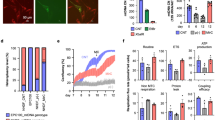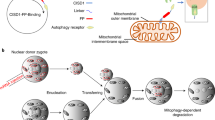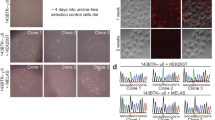Abstract
Mice carrying mitochondrial DNA (mtDNA) with pathogenic mutations would provide a system in which to study how mutant mtDNAs are transmitted and distributed in tissues, resulting in expression of mitochondrial diseases. However, no effective procedures are available for the generation of these mice. Isolation of mouse cells without mtDNA (ρ0) enabled us to trap mutant mtDNA that had accumulated in somatic tissues into ρ0 cells repopulated with mtDNA (cybrids). We isolated respiration-deficient cybrids with mtDNA carrying a deletion and introduced this mtDNA into fertilized eggs. The mutant mtDNA was transmitted maternally, and its accumulation induced mitochondrial dysfunction in various tissues. Moreover, most of these mice died because of renal failure, suggesting the involvement of mtDNA mutations in the pathogeneses of new diseases.
This is a preview of subscription content, access via your institution
Access options
Subscribe to this journal
Receive 12 print issues and online access
$209.00 per year
only $17.42 per issue
Buy this article
- Purchase on Springer Link
- Instant access to full article PDF
Prices may be subject to local taxes which are calculated during checkout






Similar content being viewed by others
References
Wallace, D.C. Mitochondrial diseases in man and mouse. Science 283, 1482–1488 (1999).
Larsson, N.-G. & Clayton, D.A. Molecular genetic aspects of human mitochondrial disorders. Annu. Rev. Genet. 29, 151–178 (1995).
Hayashi, J.-I. et al. Introduction of disease-related mitochondrial DNA deletions into HeLa cells lacking mitochondrial DNA results in mitochondrial dysfunction. Proc. Natl Acad. Sci. USA 88, 10614–10618 (1991).
Chomyn, A. et al. In vitro genetic transfer of protein synthesis and respiration defects to mitochondrial DNA-less cells with myopathy-patient mitochondria. Mol. Cell. Biol. 11, 2236–2244 (1991).
King, M.P., Koga, Y., Davidson, M. & Schon, E.A. Defects in mitochondrial protein synthesis and respiratory chain activity segregate with the tRNALeu(UUR) mutation associated with mitochondrial myopathy encephalopathy, lactic acidosis, and strokelike episodes. Mol. Cell. Biol. 12, 480–490 (1992).
Yoneda, M., Miyatake, T. & Attardi, G. Complementation of mutant and wild-type human mitochondrial DNAs coexisting since the mutation event and lack of complementation of DNAs introduced separately into a cell with distinct organelles. Mol. Cell. Biol. 14, 2699–2712 (1994).
Ito, S. et al. Functional integrity of mitochondrial genomes in human platelets and autopsied brain tissues from elderly patients with Alzheimer's disease. Proc. Natl Acad. Sci. USA 96, 2099–2103 (1999).
Inoue, K. et al. Isolation of mitochondrial DNA-less mouse cell lines and their application for trapping mouse synaptosomal mitochondrial DNA with deletion mutations. J. Biol. Chem. 272, 15510–15515 (1997).
Inoue, K. et al. Isolation and characterization of mitochondrial DNA-less lines from various mammalian cell lines by application of an anticancer drug, ditercalinium. Biochem. Biophys. Res. Commun. 239, 257–260 (1997).
Nelson, I., Gerasimov, S., Marsac, C., Lestienne, P. & Boursot, P. Sequence analysis of a deleted mitochondrial DNA molecule in heteroplasmic mice. Mamm. Genome 4, 680–683 (1993).
Tanhauser, S.M. & Laipis, P.J. Multiple deletions are detectable in mitochondrial DNA of aging mice. J. Biol. Chem. 270, 24769–24775 (1995).
Clayton, D.A, & Vinograd, J. Circular dimer and catenate forms of mitochondrial DNA in human leukaemic leucocytes. Nature 216, 652–657 (1967).
Kaneda, H. et al. Elimination of paternal mitochondrial DNA in intraspecific crosses during early mouse embryogenesis. Proc. Natl Acad. Sci. USA 92, 4542–4546 (1995).
Shitara, H. et al. Maternal inheritance of mouse mtDNA in interspecific hybrids: segregation of the leaked paternal mtDNA followed by the prevention of subsequent paternal leakage. Genetics 148, 851–857 (1998).
Poulton, J., Deadman, M.E. & Gardiner, R.M. Duplications of mitochondrial DNA in mitochondrial myopathy. Lancet 1, 236–240 (1989).
Rotig, A. et al. Maternally inherited duplication of the mitochondrial genome in a syndrome of proximal tubulopathy, diabetes mellitus, and cerebellar ataxia. Am. J. Hum. Genet. 50, 364–370 (1992).
Dunbar, D.R. et al. Maternally transmitted partial direct tandem duplication of mitochondrial DNA associated with diabetes mellitus. Hum. Mol. Genet. 10, 1619–1624 (1993).
Ballinger, S.W., Shoffner, J.M., Gebhart, S., Koontz, D.A. & Wallace, D.C. Mitochondrial diabetes revisited. Nature Genet. 7, 458–459 (1994).
Hayashi, J.-I., Takemitsu, M., Goto, Y.-i. & Nonaka, I. Human mitochondria and mitochondrial genome function as a single dynamic cellular unit. J. Cell Biol. 125, 43–50 (1994).
Takai, D. et al. Interorganellar interaction between distinct human mitochondria with deletion mutant mtDNA from a patient with mitochondrial disease and with HeLa mtDNA. J. Biol. Chem. 272, 6028–6033 (1997).
Jansen, J.J. et al. Mutation in mitochondrial tRNA(Leu(UUR)) gene associated with progressive kidney disease. J. Am. Soc. Nephrol. 8,1118–1124 (1997).
Szabolcs, M.J. et al. Mitochondrial DNA deletion: a cause of chronic tubulointerstitial nephropathy. Kidney Int. 45, 1388–1396 (1994).
Pinkert, C.A., Irwin, M.H., Johnson, L.W. & Moffatt, R.J. Mitochondria transfer into mouse ova by microinjection. Transgenic Res. 6, 379–383 (1997).
Irwin, M.H., Johnson, L.W. & Pinkert, C.A. Isolation and microinjection of somatic cell derived mitochondria and germline heteroplasmy in transmitochondrial mice. Transgenic Res. 8, 119–123 (1999).
Shitara, H. et al. Selective and continuous elimination of mitochondria microinjected into mouse eggs from spermatids, but not from liver cells, occurs throughout embryogenesis. Genetics (in press).
Volz-Lingenhohl, A., Solignac, M. & Sperlich, D. Stable heteroplasmy for a large-scale deletion in the coding region of Drosophila subobscura mitochondrial DNA. Proc. Natl Acad. Sci. USA 89, 11528–11532 (1992).
Goto, Y.-i., Nonaka, I. & Horai, S. A mutation in the tRNALeu(UUR) gene associated with the MELAS subgroup of mitochondrial encephalomyopathies. Nature 348, 651–653 (1990).
Shoffner, J.M. et al. Myoclonic epilepsy and ragged-red fiber disease (MERRF) is associated with a mitochondrial DNA tRNALys mutation. Cell 61, 931–937 (1990).
Holt, I.J., Harding, A. & Morgan-Hughes, J.A. Deletions of muscle mitochondrial DNA in patients with mitochondrial myopathies. Nature 331, 717–719 (1988).
Wang, J. et al. Dilated cardiomyopathy and atrioventricular conduction blocks induced by heart-specific inactivation of mitochondrial DNA gene expression. Nature Genet. 21, 133–137 (1999).
Marchington, D.R., Barlow, D. & Poulton, J. Transmitochondrial mice carrying resistance to chloramphenicol on mitochondrial DNA: developing the first mouse model of mitochondrial DNA disease. Nature Med. 5, 957–960 (1999).
Levy, S.E., Waymire, K.G., Kim, Y.L., MacGregor, G.R. & Wallace, D.C. Transfer of chloramphenicol-resistant mitochondrial DNA into the chimeric mouse. Transgenic Res. 8, 137–145 (1999).
Yamaoka, M. et al. Complete repopulation of mouse mitochondrial DNA-less cells with rat mitochondrial DNA restores mitochondrial translation but not mitochondrial respiratory functions. Genetics 155, 301–307 (2000).
Miyabayashi, S. et al. Cytochrome c oxidase deficiency in two siblings with Leigh encephalomyelopathy. Brain Dev. 6, 362–372 (1984).
Author information
Authors and Affiliations
Corresponding author
Rights and permissions
About this article
Cite this article
Inoue, K., Nakada, K., Ogura, A. et al. Generation of mice with mitochondrial dysfunction by introducing mouse mtDNA carrying a deletion into zygotes. Nat Genet 26, 176–181 (2000). https://doi.org/10.1038/82826
Received:
Accepted:
Issue Date:
DOI: https://doi.org/10.1038/82826
This article is cited by
-
Pearson syndrome: a multisystem mitochondrial disease with bone marrow failure
Orphanet Journal of Rare Diseases (2022)
-
Organization and expression of the mammalian mitochondrial genome
Nature Reviews Genetics (2022)
-
Sex differences in the intergenerational inheritance of metabolic traits
Nature Metabolism (2022)
-
Disruption of the mouse Shmt2 gene confers embryonic anaemia via foetal liver-specific metabolomic disorders
Scientific Reports (2019)
-
Mitochondrial dysfunction in diabetic kidney disease
Nature Reviews Nephrology (2018)



